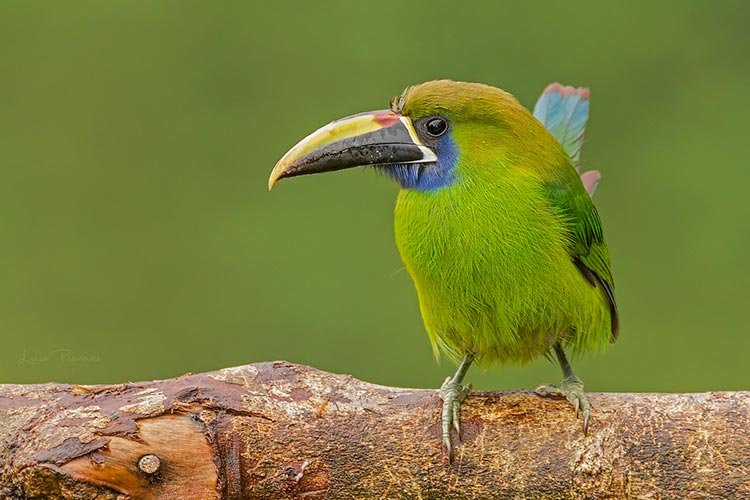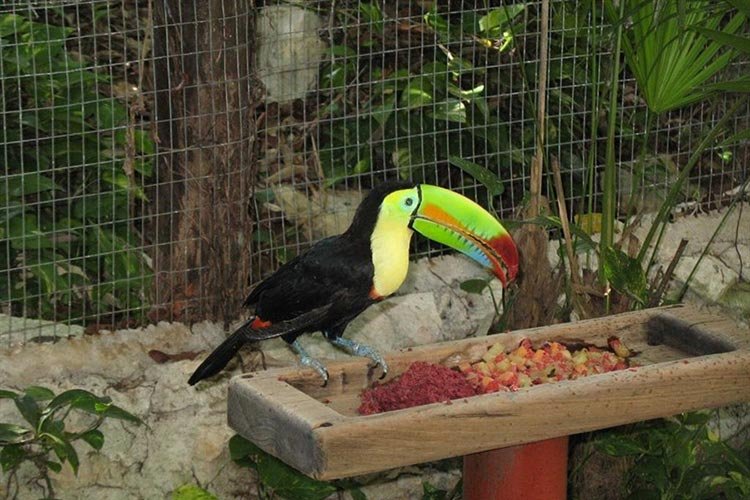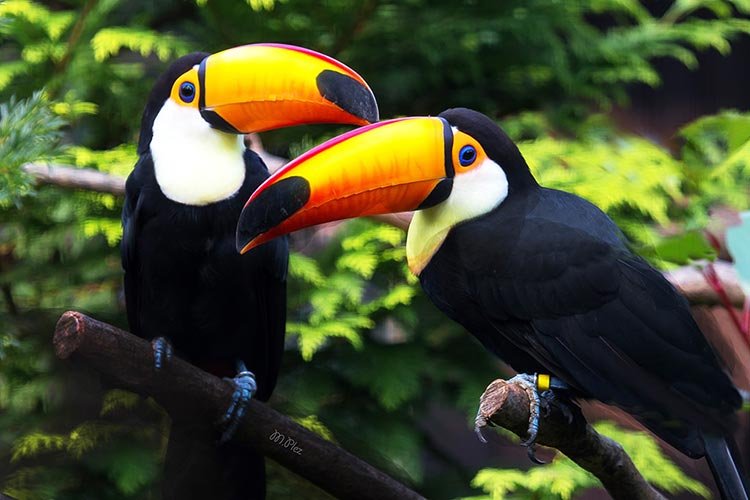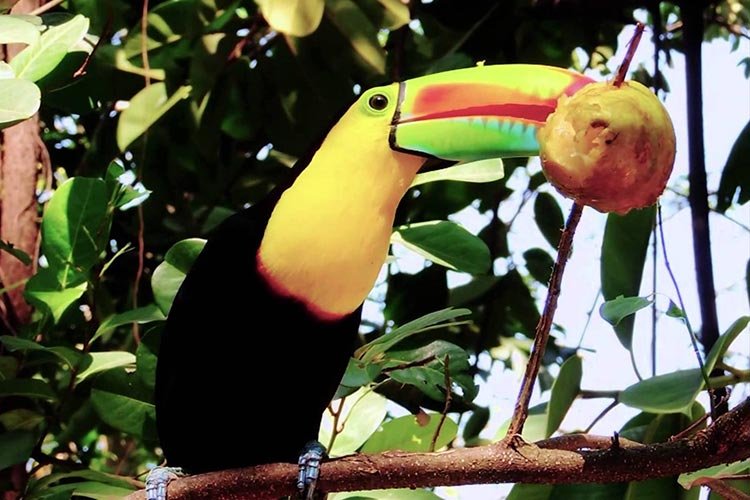
Toucans, hailing from the diverse toucan family, are some of the most recognizable and beloved birds in the world, thanks to their brightly colored bill, large beak, and comical appearance. With their enormous bills, stunning colors, and unique behaviors, these beautiful birds have captured the hearts of many. In this comprehensive guide, we’ll explore the fascinating world of toucans, delving into their distinct characteristics such as the toucan’s beak and toucan bill, as well as their behaviors, habitats, and the crucial role they play in their ecosystems.
Types of toucans
There are approximately 40 species of toucans, divided into five extant genera. Some of the most well-known species include the Toco Toucan, Emerald Toucanet, and various Mountain Toucans.
Toco Toucan (Ramphastos toco)
The Toco Toucan is the largest and most well-known species of toucan. Its striking appearance, characterized by its enormous bill and vibrant black, white, and orange plumage, makes it a popular symbol of the rainforest. The Toco Toucan is found throughout South America, inhabiting a wide range of habitats, from rainforests to savannas.
Emerald Toucanet (Aulacorhynchus prasinus)
The Emerald Toucanet is a smaller, more compact species found in the mountainous regions of Central and South America. Its predominantly green plumage, accented by a blue throat and red undertail coverts, helps it blend into the forest canopy. Emerald Toucanets are often kept as pets due to their smaller size, but they still require specialized care and attention.
Keel-Billed Toucan (Ramphastos sulfuratus)
The Keel-Billed Toucan, also known as the Rainbow-Billed Toucan or rainbow toucan, is another iconic species known for its colorful beak. It can be found throughout Central America and northern South America. The Keel-Billed Toucan’s bright, multicolored bill is thought to play a role in attracting potential mates and intimidating rival birds.
Guianan Toucanet (Selenidera piperivora)
The Guianan Toucanet (Selenidera piperivora) is a small, colorful toucan native to the north-eastern Amazon rainforest. Boasting green plumage, a yellow collar, and a uniquely patterned bill, it inhabits moist forests’ mid-levels. Primarily frugivorous, this bird plays a vital role in seed dispersal, contributing to the forest ecosystem’s health and diversity.
Mountain Toucans
Mountain toucans are a group of toucan species adapted to life in high-altitude forests. Some notable species include the Plate-Billed Mountain Toucan (Andigena laminirostris), the Hooded Mountain Toucan (Andigena cucullata), and the Black-Billed Mountain Toucan (Andigena nigrirostris). These birds are characterized by their striking plumage and specialized bills, which are adapted to feeding on specific fruits found in their montane habitats.

Toucan Characteristics
Toucan’s Bill
The most striking feature of any toucan is its large bill. While it may appear cumbersome, the toucan’s bill is actually lightweight, thanks to a honeycomb structure of bony fibers. The bill serves several purposes: it helps the bird reach fruit on branches too small to support its weight, acts as a very useful tool for grabbing and tossing fruit, and plays a role in attracting mates during the breeding season.
Colorful Beaks
The toucan’s bill comes in a range of colors and patterns, from the Toco Toucan’s bright orange and black to the more subdued hues of the Emerald Toucanet. The bill’s vibrant colors help the bird blend in with its surroundings, serving as camouflage in the dense foliage of the rainforest canopy.
Feathers
Toucans are covered in beautiful and vibrant feathers that aid in their camouflage and help them attract mates. The feathers begin to grow in patterns, with some species displaying stunning combinations of colors, such as the fiery red and yellow feathers of the Fiery-Billed Aracari.

Toucan Behavior and Socialization
What Do Toucans Eat?
Toucans are primarily frugivores, meaning their diet consists mostly of fruit. They play a vital role in their ecosystems, as the birds pass seeds from the fruit they consume, helping to disperse plants throughout the forest. In addition to fruit, toucans also eat small reptiles, insects, and even eggs from other birds’ nests. So, what do toucans eat most often? Their diet varies depending on the species and habitat, but fruit remains their primary food source.
Nesting and Breeding Habits
Toucans nest in tree cavities, often using hollowed-out tree cavities or old woodpecker holes. They do not create their own nesting cavities but instead rely on existing ones or those created by other animals. During the breeding season, toucans form monogamous pairs, and in some cases, do toucans mate for life. The female lays two to four eggs, and both the male and female incubate the eggs for about 16 days. The chicks are born with their eyes closed and are completely dependent on their parents for the first few weeks of life.
Communication and Interaction with Other Birds
Toucans are social birds and can often be found in loose flocks or small family groups. They communicate with each other using a variety of vocalizations, including loud calls and bill clattering sounds. Toucans also interact with other birds in their habitats, such as parrots and woodpeckers, and may engage in mutualistic relationships, like sharing food resources or nesting cavities.

Toucan Habitats
Where do toucans live?
Toucans inhabit the tropical and subtropical forests of Central and South America, from southern Mexico to northern Argentina. Their preferred habitats include lowland rainforests, mountain forests, and even some non-forest living toucan species that inhabit savannas and grasslands. Within these diverse environments, toucans in the rainforest primarily dwell in the lush canopy layer, making use of the abundant resources found there. Most toucans spend their time in the rainforest canopy, foraging for food and nesting in tree cavities.
But, where do toucans live in the rainforest? Rainforest toucans are well-adapted to their environment, skillfully navigating the dense foliage and branches to forage for food and seek shelter in tree cavities for nesting. These captivating birds are perfectly suited to their rainforest homes, playing a crucial role in the ecosystem and adding a vibrant touch of color to the already rich biodiversity of these tropical paradises.
Habitat Loss and Conservation Efforts
Habitat loss due to deforestation and the expansion of agriculture has led to a decline in toucan populations. The conservation status of some species, such as the Toco Toucan and the Plate-Billed Mountain Toucan, is listed as near threatened or vulnerable. Efforts to protect these magnificent birds include habitat restoration and preservation, as well as public education about the importance of toucans in maintaining the health of their ecosystems. You can find mor information in the IUCN Red List.
Toucan Reproduction and Nesting
Breeding Season
Toucans typically breed during the rainy season, which coincides with an abundance of fruit in their environment. This season can vary depending on the specific species and their geographical location but generally occurs between March and June.
Courtship Ritual
Toucan courtship rituals often involve the male and female birds engaging in a variety of displays, such as bill-clashing, vocalizations, and the tossing of fruit back and forth between the pair. These displays are thought to help strengthen the bond between the birds and attract potential mates.
Nesting Cavities
Toucans nest in tree cavities, often utilizing natural hollows in trees or abandoned woodpecker holes. They may also create their own nesting cavities by excavating rotten wood or enlarging existing holes. Both male and female toucans contribute to the creation and maintenance of the nest.
Eggs and Incubation
Once a suitable nesting cavity has been prepared, the female lays between two and four eggs. Both the male and female incubate the eggs, taking turns to keep them warm and protected. The incubation period for toucan eggs ranges from 16 to 20 days, depending on the species.
Chick Development and Fledging
Toucan chicks are born blind and completely dependent on their parents for warmth, food, and protection. The male and female both feed the chicks by regurgitating partially digested food. As the chicks grow, their eyes open, and they begin to develop their distinctive bills and feathers.
After six to eight weeks, the toucan chicks are ready to leave the nest and become independent. They continue to stay close to their parents and learn vital skills such as foraging and flying.

Toucan Interactions with Other Animals
Symbiotic Relationships
Toucans play an essential role in the ecosystem by helping to disperse seeds from the fruit they consume. As the birds eat fruit, they digest the soft outer layers and pass the seeds in their droppings. This process helps to replant the rainforest and maintain a diverse array of plant species.
Predators
Toucans face several natural predators, including jaguars, forest eagles, and hawks. Their brightly colored bills and plumage can make them easy to spot in the rainforest canopy, making them vulnerable to attack. To minimize this risk, toucans often remain hidden among the dense foliage and only venture out to feed in the early morning or late afternoon when predators are less active.
Competition
Toucans often compete with other birds, such as parrots and woodpeckers, for nesting cavities and food resources. Their large bills and strong, agile bodies allow them to defend their territory and outcompete other birds for access to fruiting trees.
Toucans as Pets
Toucan Cages and Care
While toucans are beautiful and fascinating birds, they are not suitable pets for everyone. They require large, spacious toucan cages or aviaries, a specialized diet of fresh fruit, and constant social interaction to thrive. Proper care also includes regular veterinary check-ups, plenty of mental stimulation, and a safe environment free from potential hazards.
Pet Trade and Ethical Considerations
The illegal pet trade poses a significant threat to wild toucan populations. Many birds are captured from their natural habitats and sold into the animal trade, resulting in a decline in wild populations and causing suffering for the individual birds. If considering a pet toucan or toucanet, it is crucial to research and obtain one from a reputable breeder, ensuring the bird has been captive-bred and not taken from the wild.

Threats to Toucans and Conservation Efforts
Habitat loss due to deforestation, agriculture expansion, and urban development poses a significant threat to toucans and their ecosystems. As these birds rely on the lush rainforest canopy for food and shelter, the loss of their natural habitat can lead to population declines and even extinction for some species.
Hunting and the Pet Trade
Toucans are also threatened by hunting and the illegal animal trade. In some areas, they are hunted for their meat, while in others, they are captured for their beautiful feathers or to be sold as pets. This not only depletes wild populations but also results in immense suffering for the individual birds.
Conservation Status and Efforts
Several toucan species are listed as near threatened, vulnerable, or endangered due to loss of habitat, hunting, and the pet trade. Conservation efforts include habitat preservation and restoration, anti-poaching measures, and public education to raise awareness about the importance of toucans in their ecosystems.
Conclusion
Toucans are truly remarkable birds, with their bright, colorful bills, and unique behaviors, hailing from the diverse toucan family of Central America and beyond. These beautiful creatures, characterized by their comical bill and large beak, play a critical role in their ecosystems by dispersing seeds and maintaining the health of the rainforest canopies and forest floor.
Protecting toucans and their habitats is essential for the preservation of these species, including the several species of small birds that share their ecosystem, and the well-being of the ecosystems they inhabit. By raising awareness and supporting conservation efforts, we can ensure that future generations can appreciate and enjoy the beauty and wonder of these amazing birds and the vital role they play in maintaining rainforest health.



